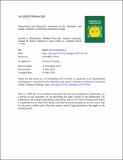Files in this item
Depositional and diagenetic constraints on the abundance and spatial variability of carbonate-associated sulfate
Item metadata
| dc.contributor.author | Richardson, Jocelyn A. | |
| dc.contributor.author | Newville, Matthew | |
| dc.contributor.author | Lanzirotti, Antonio | |
| dc.contributor.author | Webb, Samuel M. | |
| dc.contributor.author | Rose, Catherine V. | |
| dc.contributor.author | Catalano, Jeffrey G. | |
| dc.contributor.author | Fike, David A. | |
| dc.date.accessioned | 2020-05-29T23:36:17Z | |
| dc.date.available | 2020-05-29T23:36:17Z | |
| dc.date.issued | 2019-09-30 | |
| dc.identifier | 259185741 | |
| dc.identifier | 1563233b-df59-4648-8844-f45b8122741d | |
| dc.identifier | 85067255113 | |
| dc.identifier | 000480333200006 | |
| dc.identifier.citation | Richardson , J A , Newville , M , Lanzirotti , A , Webb , S M , Rose , C V , Catalano , J G & Fike , D A 2019 , ' Depositional and diagenetic constraints on the abundance and spatial variability of carbonate-associated sulfate ' , Chemical Geology , vol. 523 , pp. 59-72 . https://doi.org/10.1016/j.chemgeo.2019.05.036 | en |
| dc.identifier.issn | 0009-2541 | |
| dc.identifier.other | RIS: urn:19CA1DDC59CB27A85186E257B1171228 | |
| dc.identifier.other | ORCID: /0000-0001-8149-0977/work/58285634 | |
| dc.identifier.uri | https://hdl.handle.net/10023/20015 | |
| dc.description | Acknowledgment is made to the donors of the American Chemical Society Petroleum Research Fund (#57548-ND2) for partial support of this research. | en |
| dc.description.abstract | Marine carbonate rocks are composed, in varying abundance, of cement, micrite, abiotic grains and fossils, which can provide information about the physical and chemical environments in which they formed. Geochemical analyses of these carbonates are not always interpreted alongside the wealth of geologic (including petrographic) information available, resulting in potentially faulty reconstructions of biogeochemical and environmental conditions. These concerns have prompted closer scrutiny of the effect of depositional lithofacies and diagenesis on carbonate proxies. Here, we have combined X-ray Absorption Near Edge Structure (XANES) spectroscopy and μ-X-ray Fluorescence (μ-XRF) imaging to map the speciation and abundance of sulfur in carbonate petrographic thin sections in Upper Ordovician carbonates from Anticosti Island, Canada and early Silurian carbonates from Gotland, Sweden, across multiple depositional facies. Lithofacies and fossil communities between Anticosti Island and Gotland are similar, which allows for comparison of changes in the dominant S species and their abundance in separate basins, associated with variations in (glacio)eustatic sea level. Sulfide abundance is greatest in mudstone, wackestone and packstone facies, where interstitial micrite hosts abundant pyrite. Sulfate abundance, as carbonate-associated sulfate (CAS), varies within individual fossil fragments, as well as within the same fossil phylum and is particularly high in unaltered brachiopods. In contrast, sulfate abundance is generally very low in micrite (near the detection limit) and generally arises in situ from sulfide that has been oxidized as opposed to true CAS. In different cement fabrics, sulfate abundance is greatest in drusy, pore-filling cements. Organic sulfur compounds are also detected and, although low in abundance, are mostly found within micrite. The detection and characterization of both inorganic sulfur and organic sulfur compounds provides a platform to understand early processes of biomineralization. This approach will broaden our understanding of the source of inorganically bound sulfate in ancient carbonates, as well as the effect of depositional setting and diagenesis on CAS incorporation, (re)mobilization, and ultimate abundance in sedimentary carbonates. Additionally, this work has implications for the CAS isotopic value of individual carbonate components that may affect interpretations of stratigraphic variability of numerous CAS sections throughout Earth history. | |
| dc.format.extent | 30681495 | |
| dc.language.iso | eng | |
| dc.relation.ispartof | Chemical Geology | en |
| dc.subject | Carbonate-associated sulfate | en |
| dc.subject | XANES spectroscopy | en |
| dc.subject | μ-XRF imaging | en |
| dc.subject | Diagenesis | en |
| dc.subject | Depositional environment | en |
| dc.subject | Sulfur isotopes | en |
| dc.subject | GE Environmental Sciences | en |
| dc.subject | QD Chemistry | en |
| dc.subject | NDAS | en |
| dc.subject | SDG 14 - Life Below Water | en |
| dc.subject.lcc | GE | en |
| dc.subject.lcc | QD | en |
| dc.title | Depositional and diagenetic constraints on the abundance and spatial variability of carbonate-associated sulfate | en |
| dc.type | Journal article | en |
| dc.contributor.institution | University of St Andrews. School of Earth & Environmental Sciences | en |
| dc.identifier.doi | https://doi.org/10.1016/j.chemgeo.2019.05.036 | |
| dc.description.status | Peer reviewed | en |
| dc.date.embargoedUntil | 2020-05-30 |
This item appears in the following Collection(s)
Items in the St Andrews Research Repository are protected by copyright, with all rights reserved, unless otherwise indicated.

